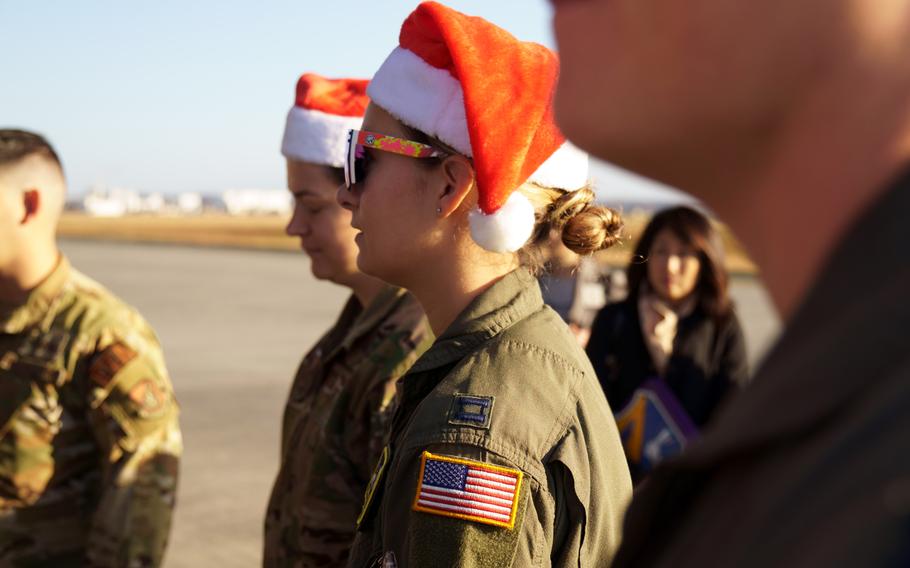
A C-130J Super Hercules crew prepares to take off from Yokota Air Base, Japan, for Operation Christmas Drop, Monday, Nov. 27, 2023. The humanitarian-aid mission serves remote islanders in the Federated States of Micronesia and Republic of Palau. (Akifumi Ishikawa/Stars and Stripes)
YOKOTA AIR BASE, Japan — The Defense Department’s longest-running humanitarian aid mission will be a novelty — Canadian airlifters in Santa hats — when it officially kicks off on Tuesday.
This will be the first time Canada has participated in Operation Christmas Drop, an annual, two-week mission to airdrop essential supplies to far-flung and isolated islands in the Federated States of Micronesia and Republic of Palau, Capt. Miranda Bapty said Monday at the home of U.S. Forces Japan in western Tokyo.
The C-130J Super Hercules pilot from Yokota’s 36th Expeditionary Airlift Squadron was preparing to take off for Andersen Air Force Base, Guam, home base of the massive operation, which runs through Dec. 13.
Three C-130Js from Yokota will help with this year’s mission. The other two airlifters are slated to link up with Bapty’s crew at Andersen later this week.
“We do these (airdrop missions) all the time,” she said. “But this is the one time we get to see the impact of all that training coming to a head.”
Now in its 72nd year, the tradition began during the Christmas season of 1952, when the crew of a B-29 Superfortress saw islanders waving at them from Kapingamarangi, Micronesia, according to a writeup on Andersen’s website.
“In the spirit of Christmas the aircrew dropped a bundle of supplies attached to a parachute to the islanders below, giving the operation its name,” the writeup said. “Today, airdrop operations include more than 50 islands throughout the Pacific.”
This year’s mission will serve 20,000 people, 374th Airlift Wing spokesman Lt. Danny Rangel said in an email Monday.
Each dropped bundle contains myriad provisions and amenities, including food, water, medical supplies, fishing gear, clothing and toys. Last year, crews from Japan, South Korea, Australia, India and New Zealand flew alongside Air Force crews from Yokota, Andersen and Joint Base Pearl Harbor-Hickam, Hawaii.
C-130H Hercules from Japan and South Korea, which participated in past Christmas Drop operations, are flying again this year, Bapty said shortly before taking off with an advance party of 40 airmen and cargo for the flight to Guam. Ground support will be provided by Australian and Filipino troops.
News of Canada’s participation comes as the country ramps up its activity in the region. Ottawa has pledged to spend $360 million through 2027 to enhance its Indo-Pacific presence.
“Canada will reinforce its Indo-Pacific naval presence and increase Canadian Armed Forces participation in regional military exercises,” the government states on its website.
That activity has made headlines in recent weeks. On Oct. 29, a pair of Chinese twin-engine, air superiority J-11 fighters buzzed a multirole Canadian CH-148 Cyclone helicopter over the South China Sea. The Cyclone was operating from the frigate HMCS Ottawa.
Four days later, the Ottawa and the guided-missile destroyer USS Rafael Peralta made a trip together through the Taiwan Strait, drawing protests from Beijing. China considers the 110-mile-wide waterway its territorial waters.
This will also be the first Christmas Drop for Bapty and her loadmaster, Master Sgt. Justin Magno, the pair said ahead of liftoff on Monday. The Super Hercules’ crew wore Santa hats and Operation Christmas Drop patches on their shoulders.
However, the two do have experience dropping cargo to small islands in southern Japanese and Palau, Bapty said.
Magno, who has been flying for 17 years, said he’s done airdrops for forward-operating bases in the Middle East but hasn’t helped a humanitarian mission on the scale of Christmas Drop.
“Most of my experience has been passengers and cargo movements or just combat movements,” he said. “An airdrop is an airdrop, but working with our partner nations is a good challenge.”